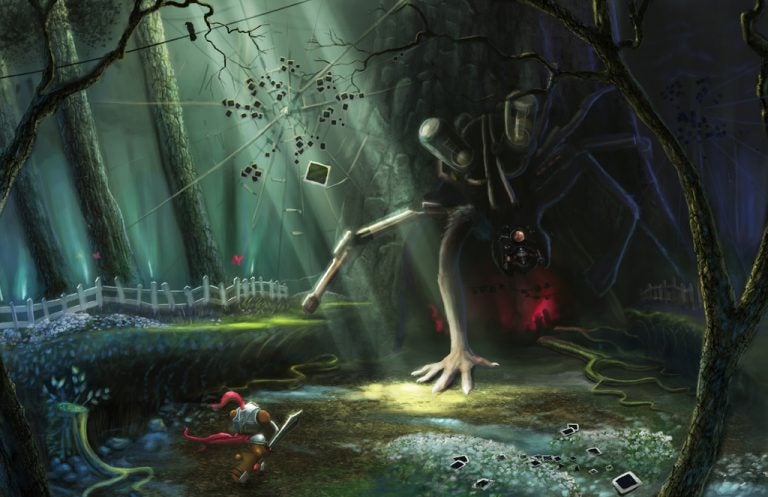According to The Princeton Review and GamePro Media, we’re ranked the number two video game graduate school in the nation. But why? How are we leading the pack? Part of the answer to that question is the hands-on education our students get early in the game—another reason is the students we hand-pick.
UCF’s Florida Interactive Entertainment Academy (FIEA) students are getting themselves ready to leap into one of the most ferocious, demanding and lucrative industries in the nation. For just one example of the business growing fast, consider this: by the end of 2012, there will be an estimated three billion gamers globally—up from 1.5 billion in 2011. It’s growing that fast.
And let me tell you—neither getting through FIEA nor working in the industry is easy. The industry’s non-stop grind of putting out quality games is something UCF intends to prepare every one of its students for.
I got to talk to a couple of FIEA students about what it’s like to be a student at FIEA and a thing or two about what makes UCF’s school unique.
They Aren’t Playing Around
UCF’s video game school is ranked second in the nation—right behind the University of Southern California’s (USC) school.
But FIEA student Charlyn Chisolm chose UCF, despite having the opportunity to choose between them. When I asked what drew her to UCF, she answered without hesitation: USC is very much about the classroom experience—FIEA is more about hitting the ground running. At FIEA, students don’t just read about making games and talk about making games. They jump in with both feet the moment they enter.
Charlyn told me about what that first semester at FIEA is like—and it’s intense. During their first semester, students do the following every two weeks:
1. Get assignment to make a video game
3. Learn a new kind of industry-used software (called an “engine”)
4. Do the art and design, coding, coordination and animation
5. Pull many, many long hours
6. Present game
7. Go to number one–rinse and repeat
And don’t forget that they are still doing course work and learning in the classroom just like any other program.
But writing five video games in a single semester is demanding and requires, in addition to talent and technical knowledge, collaboration and project management skills. Just think: each game has to involve a team of artists, coders, designers and producers who pull all of these elements together to make a game and make it right.
For example, learning a new software—or “engines,” as they’re called—can take several hours to days. And the students do all of this about five times that first semester—by the end of the semester, they’ve been introduced to all the major engines the industry uses.
After the intense kick-start of the first semester, the following semester the students then prepare to design a full-concept, fully designed video game—and then pitch that concept to the faculty, staff and other students to see if their games get picked to be made.
For the games that get picked, the teams are assigned by faculty and staff. A producer then leads a team of about two people through eight months of intense designing and concepting, hands-on designing and coding. Checkpoints along the way ensure they’re making industry-level progress and work. If they aren’t, their games get cut.
But, as Joey Hannes, a student who finished his capstone in August and has now graduated and moved on to a job at Jogonaut, pointed out to me, there’s an even more intense experience waiting for them on the other side of the pitches. The real work was about to hit them all.
A Pressure-Cooker with Purpose
So, how does this different approach help our students succeed when they graduate? How does this hands-on approach make them more marketable job candidates?
Every person I’ve spoken to, from students to staff, all start by saying one thing about the program: it’s rigorous—because the industry is intense. You don’t theorize about making games at a major company, you make them. You need endurance, stamina and drive.
Joey described the daily routine at FIEA and the sobering effect the program provides students before they get jobs.
“Until you get here, you have no idea what it takes to make it. You’re making video games and it seems glorious, but then there’s an absolute grind” he says. “You can get overwhelmed, but you just have to learn to overcome that hurdle.”
But that’s how their jobs will be once they graduate
“The industry has really matured and it just isn’t what it was in the 80s and 90s where you made a game, enjoyed the profits and then eventually started up a new game,” Hannes explains. “There’s very serious people in charge of these companies for good reason, and they’re turning out amazing profits—at the end of the day it’s a business, now. It’s a seriously competitive, cut-throat industry.”
It’s not an easy industry to work in—FIEA isn’t an easy program.
The bottom line is that UCF is instituting a program that doesn’t just bog students down with course work, though they’re serious about that too. Instead, it additionally tasks every student with learning several industry engines and to make a video game they can showcase at conventions where they can rub elbows with some of the biggest companies in the industry—for instance, the Special Interest Group on Graphics and Interactive Techniques (SIGGRAPH) conference and the Game Developers Conference.
And they get jobs. Good ones. Where have our students gone on to succeed? Well, there’s a ton of stories right there just waiting to be told.
To learn more about what’s happening at FIEA, visit fiea.ucf.edu—click on “student work” to see what our students have been up to.
